Advertisements
Advertisements
प्रश्न
Prove that, if a line parallel to a side of a triangle intersects the other sides in two district points, then the line divides those sides in proportion.
Prove that, 'If a line parallel to a side of a triangle intersects the remaining sides in two distinct points, then the line divides the side in the same proportion’.
उत्तर १
Given: A Δ ABC in which DE||BC, and intersect AB in D and AC in E.
To Prove: `"AD"/"BD" = "AE"/"EC"`
Construction: Join BE, CD, and draw EF⊥ BA and DG⊥CA.

Proof:
Area ∆ADE = `1/2 xx ("base" xx "height") =1/2("AD. EF")`
Area ∆DBE = `1/2 xx("base" xx "height") =1/2("DB.EF")`
⇒ `("Area"(triangle"ADE"))/("Area"(triangle"DBE"))=[((1/2"AD. EF"))/((1/2"DB. EF")]] = "AD"/"DB"`
Similarly,
⇒ `("Area"(triangle"ADE"))/("Area"(triangle"DBE"))=[((1/2"AE. DG"))/((1/2"EC. DG")]] = "AE"/"EC"`
ΔDBE and ΔDEC are on the same base DE and BC the same parallel DE and BC.
∴ Area (ΔDBE) = Area (ΔDEC)
⇒ `1/("Area"(triangle"DBE")) =1/("Area"(triangle"DEC"))` ...[Taking reciprocal of both sides]
⇒ `("Area"(triangle"ADE"))/("Area"(triangle"DBE"))=("Area"(triangle"ADE"))/("Area"(triangle"DEC")` ...[Multiplying both sides by Area (ΔADE)]
⇒ `"AD"/"DB"="AE"/"EC"`
Hence Proved.
उत्तर २
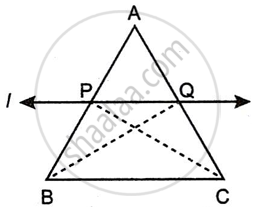
Given: In Δ ABC line l || line BC and line l intersects AB and AC in point P and Q respectively.
To prove: `"AP"/"PB" = "AQ"/"QC"`
Construction: Draw seg PC and seg BQ.
Proof: ΔAPQ and ΔPQB have equal heights.
`therefore ("A"(Delta "APQ"))/("A"(Delta "PQB")) = "AP"/"PB"` (areas proportionate to bases) ...(I)
and `("A"(Delta "APQ"))/("A"(Delta "PQC")) = "AQ"/"QC"` (areas proportionate to bases) ...(II)
Seg PQ is the common base of ΔPQB and ΔPQC, seg PQ || seg BC,
Hence ΔPQB and ΔPQC have equal areas.
A(ΔPQB) = A(ΔPQC) ...(III)
`("A"(Delta "APQ"))/("A"(Delta "PQB")) = ("A"(Delta "APQ"))/("A"(Delta "PQC"))` ...[from (I), (II) and (III)]
`therefore "AP"/"PB" = "AQ"/"QC"` ...[from (I) and (II)]
Hence Proved.
संबंधित प्रश्न
In the following figure, DE || AC and DF || AE. Prove that `("BF")/("FE") = ("BE")/("EC")`

In the given figure, D is a point on side BC of ΔABC such that ∠ADC=∠BAC . Prove that AD is the bisector of ∠BAC.
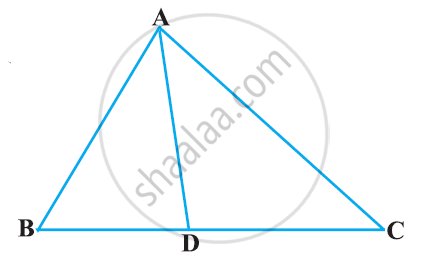
In ΔABC, D and E are points on the sides AB and AC respectively such that DE || BC
If AD = 4, AE = 8, DB = x – 4, and EC = 3x – 19, find x.
In ΔABC, D and E are points on the sides AB and AC respectively such that DE || BC
If AD = 8cm, AB = 12 cm and AE = 12 cm, find CE.
In ΔABC, D and E are points on the sides AB and AC respectively such that DE || BC
If AD = 2 cm, AB = 6 cm and AC = 9 cm, find AE.
In a ΔABC, D and E are points on the sides AB and AC respectively. For the following case show that DE || BC
AB = 10.8 cm, BD = 4.5 cm, AC = 4.8 cm and AE = 2.8 cm.
D and E are points on the sides AB and AC respectively of a ΔABC such that DE║BC.
If AB = 13.3cm, AC = 11.9cm and EC = 5.1cm, find AD.
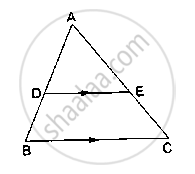
D and E are points on the sides AB and AC respectively of a ΔABC such that DE║BC.
If `(AD)/(DB) = 4/7` and AC = 6.6cm, find AE.

D and E are points on the sides AB and AC respectively of a ΔABC such that DE║BC. Find the value of x, when
AD = 4cm, DB = (x – 4) cm, AE = 8cm and EC = (3x – 19) cm.
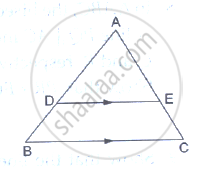
ABCD is a parallelogram in which P is the midpoint of DC and Q is a point on AC such that CQ = `1/4` AC. If PQ produced meets BC at R, prove that R is the midpoint of BC.

A guy wire attached to a vertical pole of height 18 m is 24m long and has a stake attached to the other end. How far from the base of the pole should the stake be driven so that the wire will be taut?
In the given figure, O is a point inside a ΔPQR such that ∠PQR such that ∠POR = 90°, OP = 6cm and OR = 8cm. If PQ = 24cm and QR = 26cm, prove that ΔPQR is right-angled.
In ΔABC, D is the midpoint of BC and AE⊥BC. If AC>AB, show that `AB^2= AD^2+1/4 BC^2 −BC.DE `
Find the length of each side of a rhombus whose diagonals are 24cm and 10cm long.
Draw an isosceles triangle with base 5 cm and height 4 cm. Draw a triangle similar to the triangle drawn whose sides are `2/3` times the sides of the triangle.
In fig, seg DE || sec BC, identify the correct statement.

In the given figure ΔABC ~ ΔPQR, PM is median of ΔPQR. If ar ΔABC = 289 cm², BC = 17 cm, MR = 6.5 cm then the area of ΔPQM is ______.
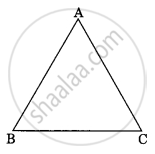 |
 |
In the given figure ∠CEF = ∠CFE. F is the midpoint of DC. Prove that `(AB)/(BD) = (AE)/(FD)`
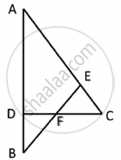
State and prove Basic Proportionality theorem.
